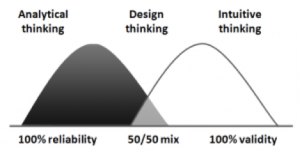Source: Slide deck on Design Thinking1
Design Thinking The Term as Prototype
Design Thinking is a term most often used to describe the work done by companies such as IDEO, Continuum, and most other design firms. According to Jess McMullen, it was coined in 1987 by Peter Rowe2, and has been most prominently popularized by Roger Martin of the Rotman School of Business in Toronto.
As described by Martin in this slideshare presentation, Design Thinking refers to Balancing analytical thinking and intuitive thinking enables to both exploit existing business and create new opportunities.
I have had an ongoing love/hate relationship with the term. An excerpt from one of my blog posts from 2008 illustrates why:
I should start by saying that I am a proponent of Design Thinking, just as I am a proponent of Business Thinking, Legal Thinking, Engineering Thinking, and Political Thinking. All are approaches to solving problems that have evolved to ensure rigor and best practices in their respective professions. Where it gets interesting is when a problem in one discipline benefits from an approach used by another discipline. The current buzz about Design Thinking is an answer to the business world’s need to innovate. The current processes used to guide businesses don’t lend themselves well to doing something new that can’t be measured by current benchmarks. Designers regularly create new solutions that have no benchmarks, so taking a page from the way they work should be helpful to achieve these goals. And it is.
What gets misleading is when the distinction is blurred between an approach that is used in a discipline, and the work, skills, and deliverables expected of professionals in that discipline. If a business person uses design thinking to develop an innovative business model, the outcome is still a business model and the profession is still that of a business person. It does not mean they should be called designers, as they do not possess the skills required of a design professional. If a designer uses business thinking to make their designs more relevant to the business, they are still designers.
You can see that I agree with Martins intended use of the term. However, I have found in practice that the term is often taken too literally, which can cause problems in strategic innovation programs. I have seen people with design backgrounds interpret this idea to mean that the development of strategy has less to do with the business, and more to do with the types of products that are designed. I have also seen people describe primary research as Applied Design Thinking. I believe that these occurrences are unintended consequences of the terminology and are inconsistent with Martins original intent. Bruce Nussbaum shared similar views and went so far as to suggest that Design Thinking is a Failed Experiment. He proposed the term Creative Intelligence in this Fast Company article, and then went on to write a book on the concept.
I prefer to call the term Design Thinking a prototype instead of a failure. Mostly because in my opinion, it hasnt failed. It served a useful purpose in raising awareness of the need to blend thinking styles and ways of working. As with any good prototype, it was useful enough that some unintended consequences were made explicit in its use. Now its time to iterate to make adjustments to the terminology to better align with the original intent. Thats very different from starting over. Bruce Nussbaums term is one iteration, and Id like to propose another.
Iterating an Alternative Term
I was recently introduced to the concept of Mindsets the work of Stanford University Professor Carol Dweck. In my words, I would describe her concept of Mindsets as the lenses through which we view the world. Dweck describes two basic Mindsets Fixed and Growth, as illustrated in the diagram below:
Image source: https://insidetheclassroomoutsidethebox.wordpress.com/category/education/
I then found the work of Linda Rising who had shared this presentation on Slideshare. She simplified the concept and altered it slightly for the Agile Software Development Process on which her work is focused.
Heres what I like about this way of thinking. First, it can be seen that either Analytical or Intuitive thinkers can have fixed mindsets, and that real integration requires that a person be focused on an outcome rather than a specific process. When working on an ambiguous challenge, its important to be focused on an outcome and understand that the process may need to be flexible enough to accommodate circumstances that have not been previously encountered. Second, it is not anchored in any specific discipline, so can easily be applied to design, engineering, marketing, or any other specific type of field.
If I were to modify Martins diagram to accommodate this point of view it would look something like this:
For me, this is a better depiction of the original intent of the Design Thinking concept. Bruce Nussbaums original concern regarding Creative Intelligence is also accommodated, as the integration of thinking types and evolution of process to achieve different outcomes is a creative exercise unto itself. It is also more consistent with the way the brain is actually working when creating new, creative ideas that I documented in my chapter on Innovation and Neuroscience.3 I will be using the term Integrative Mindset in my work when I want to describe a blend of different thinking or working styles. That is, until the need to iterate again becomes apparent. To paraphrase Heraclitus, Change is the only constant.
Isnt that whats at the heart of an Innovative Mindset anyway?
_______________________________________
[1] Roger Martins thoughts on Design Thinking slide deck – http://www.slideshare.net/fred.zimny/slide-deck-by-roger-martin-the-design-of-business-presentation
[2] Blog comment from Jess McMullin As far as origins, Peter Rowe wrote a book called Design Thinking that came out in 1987. http://bit.ly/rowe_design_thinking#sthash.x0s2OXRj.dpuf
[3] McGraw Hill Professional – http://www.mhprofessional.com/product.php?isbn=0071819215



